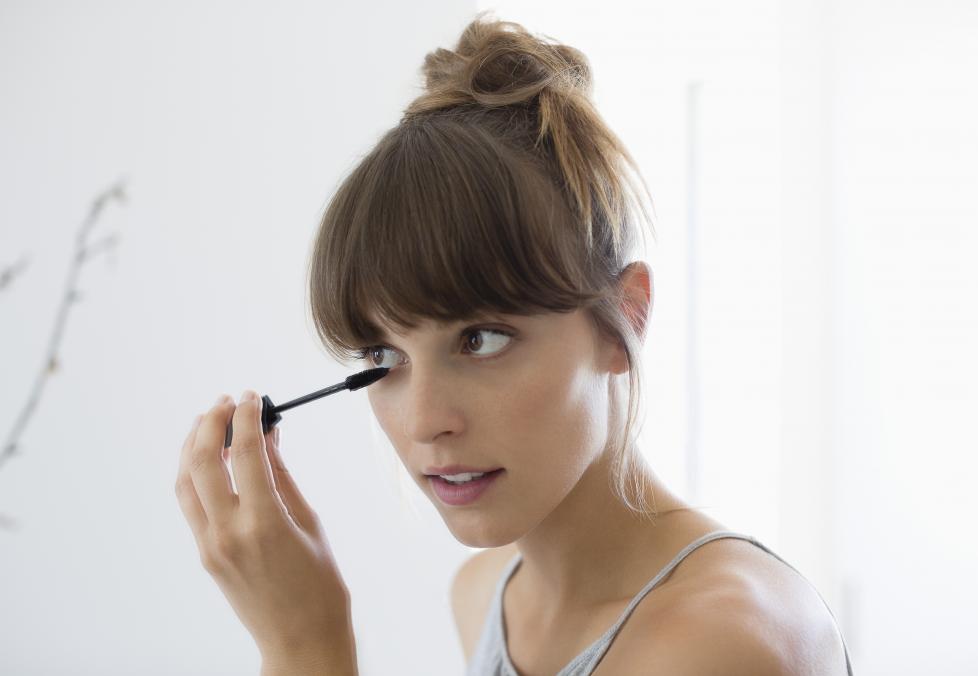
Treat your eyes to a free quality eye exam with our popular two-pair offer.
Everything you need to know to take care of your eyes — for life.
Cosmetics are a leading cause of eye diseases and injuries. Adopt these simple eye-care habits to protect yourself.

Your eyes have an enemy, and it’s hiding in your purse: your cosmetics bag.
Eye care may not be top of mind when applying makeup, but it should be. Mascara wands can scratch with an accidental jab. Glitter bits and flakes of eye shadow can irritate and inflame. And dangerous ingredients or contaminated products can cause bacterial or fungal infections.
“The pursuit of beauty can come with serious health costs if you’re not careful,” says Julie Schaefer, O.D., an optometrist at South Florida Regional Eye Associates, located in an America’s Best Contacts and Eyeglasses in Miami.
Use this handy checklist to clean up your makeup habits—and safeguard your vision.
Have questions about your vision or eye health? Reach out to your America’s Best optometrist, who is an important part of your care team. Click here to make an appointment.
Most cosmetics contain preservatives, but bacteria and other germs get in the mix the first time you open the case.
Not all germs pose a problem, but consider this: When Polish researchers ran lab tests on 55 cosmetics from women’s makeup bags in a 2017 study, they found staph bacteria in 20 percent of the items and fungi in 7 percent. Yuck!
Set a reminder on your smartphone to make the swap, or go old-school and write the ballpark replacement date on the containers.
Anyone who’s ever worked in retail knows how crazy-busy the staff can be. Who knows if, when, or how often the testers are sanitized?
Even if the staff is diligent, we have two words for you: double dippers. Yep, your fellow shoppers might be reusing those disposable wands and swabs. Always ask for a fresh tester, and only test shadows and liners on your hands.
Consider bringing alcohol spray or wipes to clean items yourself, or shop at stores with solid return policies and try new products at home instead.
Getting an in-store makeover? Make sure the makeup artist sanitizes their hands first—and inspect the brushes and wands they use. If the space doesn’t sparkle, keep walking.
Washing your hands before applying makeup, and cleaning your brushes and applicators weekly, should be your first lines of defense against nasty germs that can irritate eyes or lead to annoying infections like pink eye.
Formally known as conjunctivitis, mild cases of pink eye don’t usually cause any long-term damage to your eyes, says Dr. Schaefer. But the burning, swelling, redness, and sticky discharge may sideline you for a few days.
Another reason to clean your brushes: You’ll remove pollen and dust that can cause allergic reactions.

Treat your eyes to a free quality eye exam with our popular two-pair offer.
In the morning rush, it’s easy to miss your target and accidentally get makeup in your eyes. Resist the urge to rub it off. That increases your chances of making the irritation worse—or of scratching your cornea, the clear outermost layer of your eye that helps you focus.
Instead, flush your eyes with lubricating drops and give them a few minutes to rest and recover before starting over. Or, skip the eye makeup for the day and make your lips and cheeks sparkle instead.
Keep eye makeup stashed while you’re healing from an eye infection, and then ease back in slowly, says Dr. Schaefer.
The American Academy of Ophthalmology suggests waiting two weeks before returning to eye makeup, in case you have any lingering “silent” symptoms.
And make sure you restart with fresh products, so that you don’t infect yourself all over again.
It’s late. You’re tired. You think, “There’s no real harm sleeping in my makeup.”
Resist that temptation, says Dr. Schaefer. It’s well worth rallying yourself for the minute or two that the removal takes. That’s because routinely hitting the pillow with makeup on can irritate your eyes and lead to chronic dry eye.
Makeup buildup can also impact eyelash roots, potentially leading to redness and ingrown lashes. A rare case of corneal scarring and vision impairment has even been reported after years of improper eye makeup removal.
Here’s how to safely clean the area:
It’s natural to want to try the latest trends and brands, but your best bet is to only add one new makeup product to your routine at a time, Dr. Schaefer says. This is especially true if you have allergies or sensitive skin.
No flare-ups after a few days? Go ahead and try another new product. But if you do have a reaction, ditch the item and save the packaging with the ingredient list to show your doctor or optometrist. He or she can help you identify the culprit chemical, so you can steer clear of it in the future.
Moving cars and makeup don’t mix, even if you’re a passenger. The inevitable starts, stops, bumps, and turns could lead to a poke in the eye with your mascara wand or makeup applicator.
Here’s a surprising fact: Putting on makeup while driving is actually riskier than making a cellphone call from behind the wheel, according to the National Highway Traffic Safety Administration. That so-called time-saving step triples your risk of an accident.